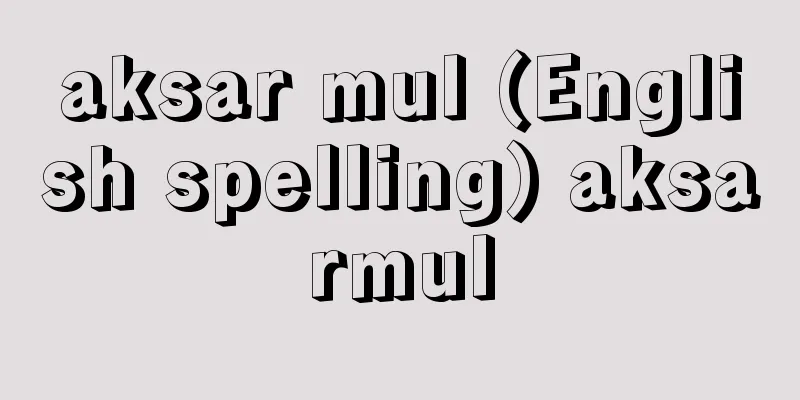Cam - Kamu (English spelling) cam

|
A device that gives a required periodic displacement to a follower by contacting a driver with a special contour with a follower that has a contactor with a simple shape such as a knife-edge roller. It has a wide range of uses because it can induce complex movements with a simple structure, and is used in various processing machines and operating machines. Also, many cams are required to obtain complex movements in automatic machines. Cams can be broadly divided into planar cams, whose contours or grooves are made of plane curves, and solid cams, whose contours or grooves are made of spatial curves. [1] Plane cams The most commonly used planar cams only push the follower up, and use gravity or spring force to pull it down. This type of cam is used to move the intake and exhaust valves of internal combustion engines. A heart cam is one that has a heart-shaped outline. It changes uniform rotational motion into uniform reciprocating linear motion. Also, when a follower is pressed toward the center of a heart cam, the follower always comes to a concave position in the heart shape, so the position of the heart cam is constant when the follower is pressed against it. This is used to return the hands to zero, like on a stopwatch. A grooved cam, which is a planar cam with grooves that allow the follower to move along the grooves, can reliably push up and down the follower. Such a cam is called a positive-motion cam. There are many types of planar cams, but some examples include the following: (1) A cam with several protrusions for raising and lowering the pestle in a stone crusher, rice pounder, etc. (2) A triangular cam, where with one rotation the rod attached to the frame makes one up and down movement, stopping at each end. In other words, when the cam rotates continuously, it produces an intermittent reciprocating motion that stops at the upper and lower poles. (3) A specially shaped mountain-shaped cam makes a reciprocating movement from side to side, and the follower mounted on it makes a special up and down movement. This is called a linear cam. [2] Three-dimensional cam Also called a solid cam. The simplest type is the slanted plate cam. A follower is placed on the end of an inclined plate, and when the slanted plate rotates at a uniform speed around the central axis, the follower moves up and down in a sinusoidal motion. A cam with grooves on the surface of a cylinder is called a cylindrical cam. When the cylinder rotates, the follower moves in a straight line along the generatrix. A cam with grooves on the surface of a cone is called a conical cam, which also gives the follower a reciprocating motion along the generatrix. A cam with grooves on the surface of a sphere attached to a horizontal axis is called a spherical cam. When the sphere is rotated around the horizontal axis, the bow-shaped protrusion attached to a vertical axis whose axis passes through the center of the sphere swings back and forth along the grooves in the sphere, and the vertical axis vibrates in a special way. [Hidetaro Nakayama] ©Shogakukan "> Main types of cams (flat cams) ©Shogakukan "> Main types of cams (3D cams) Source: Shogakukan Encyclopedia Nipponica About Encyclopedia Nipponica Information | Legend |
|
特殊の輪郭をもっている原動節と、ナイフエッジ・ローラーのような簡単な形状の接触子をもつ従動節との接触によって、従動節に所要の周期的変位を与える装置。簡単な構造で複雑な運動を導くことができるので利用範囲は広く、各種加工機械や作業機械などに使用されている。また自動機械の複雑な運動を得るためにも多数のカムが必要である。 カムはその輪郭または溝が平面曲線でできている平面カムと、空間曲線でできている立体カムとに大別できる。 〔1〕平面カム もっとも普通に用いられている板カムは、従動節を押し上げるだけで、引き下げるのには重力によるか、あるいはばねの力を使う。内燃機関の吸排気弁を動かすのにこの種のカムが使用されている。輪郭がハート形をしているものをハートカムという。これは等速回転運動を等速往復直線運動に変えるものである。またハートカムは、その中心に向かって従動節を押し付けると、従動節はつねにハート形のくぼんだ位置にくるので、従動節を押し付けたときのハートカムの位置は一定である。これを利用して、ストップウォッチのように針をゼロの位置に戻すのに利用されている。平面カムで溝をつけ従動節を溝に沿って動くようにした溝カムは、従動節を確実に押し上げ、また引き下げることができる。このようなカムを確動カムという。 平面カムの種類は多いが、例としていくつかあげると次のようなものがある。(1)砕石機、米搗(こめつ)き機などの杵(きね)を上下させるために突起をいくつかもったカム。(2)三角形状で、1回転すると枠についている棒は1回の上下運動をし、それぞれその終端で静止させるカム。すなわちカムが連続的に回転すると上下の極で静止する間欠往復運動が得られる。(3)特殊の形状をもつ山形のカムは、左右に往復運動をすると、この上にのっている従動節は特殊な上下運動をする。これは直動カムという。 〔2〕立体カム 実体カムともいう。もっとも簡単なのは斜板カムである。斜めの板の端に従動節がのっているもので、斜板が中心軸の周りに等速回転運動をすると従動節は上下の正弦運動をする。円筒の表面に溝をつけたものを円筒カムという。円筒が回転すると母線に沿って従動節は直線運動をする。また円錐(えんすい)の表面に溝をつけたものを円錐カムといい、やはり母線に沿って従動節に往復運動を与える。水平軸を取り付けた球の表面に溝をつけたものを球面カムという。水平軸の周りに球を回転させると、軸線が球の中心を通過する垂直軸に取り付けた弓状片の突起が球の溝に沿って左右に振れ動き、垂直軸は特殊な振動をする。 [中山秀太郎] ©Shogakukan"> カムのおもな種類(平面カム) ©Shogakukan"> カムのおもな種類(立体カム) 出典 小学館 日本大百科全書(ニッポニカ)日本大百科全書(ニッポニカ)について 情報 | 凡例 |
Recommend
stipple method
…The German Expressionists were also attracted to...
Ørsted, Hans Christian
Born: August 14, 1777, Rooskebing, Langeland Died ...
Scale foil - Urokohaku
…The color of the fabric changes depending on the...
photoelectric cell
...Photomultiplier tubes are used for high sensit...
Electrolytic polishing - Denkaikenma
This is a distortion-free polishing method in whi...
Anacreon Wind - Anacreon Wind
…His Melos is a work for solo singing, and becaus...
Vetch - Vetch (English spelling)
A general term for many species of the Vicia genu...
Port Moresby (English spelling)
The capital of Papua New Guinea. It is located on ...
Ezochichi cicada - Ezochichi cicada
...It is found from plains to mountainous areas, ...
Gouldner, A.
… However, in today's advanced industrial soc...
Cart
...A menu for a meal in which the types and order...
Monastir
…The town was founded by the Slavs in the 11th ce...
Air pressure distribution - Air pressure distribution
…The relationship between these units is as follo...
Freezing period
Refers to the period in winter when the soil freez...
Disease Story - Disease Story
A picture scroll that collects stories of strange...









